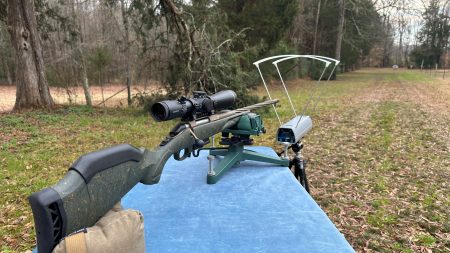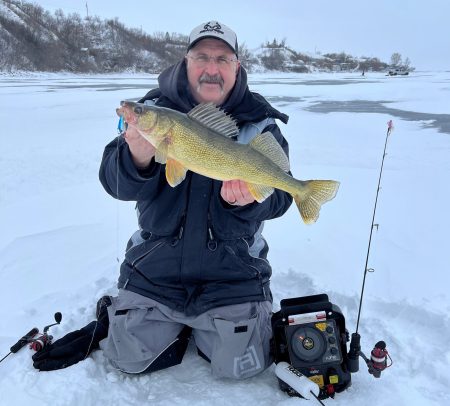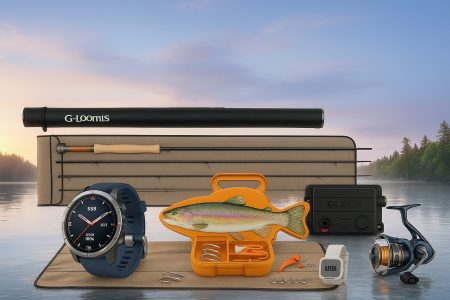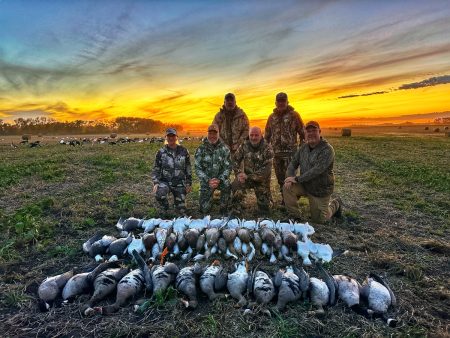When it comes to chasing trophy birds in rugged country, the Mossberg 940 Pro Turkey shotgun is built to deliver. On our recent high desert Gould’s turkey hunt in Sonora, Mexico, this optic-ready 12-gauge proved its worth with tight, consistent patterns and smooth handling in the blind. From patterning Apex TSS loads at the range to dropping mature longbeards at close range, the 940 Pro Turkey showed why it’s one of the most trusted autoloaders for serious turkey hunters. The best time to book a turkey hunt for next spring is right now, and here is a little food for thought about an often-overlooked bucket list adventure.
Orange and violet hues backlit the mountains as the early morning sun tried to break over the horizon. The jagged peaks looked old and weathered. The 8,000-foot rocky cliffs are considered high desert in the Sierra Madre Mountains in Sonora, Mexico, and home to the Gould’s turkey. We wound our way down rough ranch roads in the dark and finally sat in a blind, awaiting the morning’s show. A long grass-covered spine led down the ridge in front of us. The creek bottom below was interspersed with scrubby oak and other native trees. Our flashlights caught the outlines of turkey tracks, and droppings were scattered along the trail while we walked in.
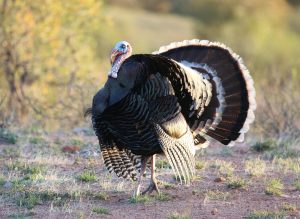
The cool morning air was refreshing. We whispered back and forth, getting settled, and our solitude was soon interrupted by the reverberation of a turkey gobble. It wasn’t just any gobble; it sounded like something was being transmitted through a tin can with plenty of extra rattles. The sound came from the north, but seconds later, another bird sounded off to the east. I was with Ted Jaycox, owner of Tall Tine Outfitters, and my hunting partner Mike Waren from Arkansas. We looked at each other with wide eyes, and big grins emerged as another bird sounded off at the bottom of our ridge.
Ted worked the tree tops below with binoculars and soon pointed out a dark blob that was a mature gobbler trying to display from the top of its roosting tree. The eastern sky was getting brighter every second, and the sounds of competing gobblers let us know the birds were getting restless. At least three gobblers were rattling off the roosts, and when the hens started to yelp, they started to fly down.

The girls hit the ground looking for breakfast, and the boys hit the ground running. The majority of birds were about 300 yards below us on the spine. A wide grassy meadow made the perfect arena for the strutters to show their stuff and dance circles around the ladies. The birds started moving up the ridge towards us, with a small group breaking off through the scrubby trees to head east. We weren’t the only ones to hear the eastern thunder under clear skies.
The hens pecked the ground, and the long-legged, colorful males stayed in full strut unless they had to lower their feathers and run to catch up to the flock. The biggest gobbler stood out at the bottom end of the ridge. He was busy courting one particular hen who showed no interest in staying with the flock. She acted rather randy, and at one point, another gobbler tried to hone in on the action. However, it was dissuaded by the king’s advance. With about six gobblers, the main flock closed in on our blind while the king and his prized hen retreated down the hill and disappeared into the jungle of trees at the bottom.
Hens walked right towards us, oblivious to the blind. We peered out the windows and remained motionless. One hen walked so close to the blind that we lost sight of her before she tangled in one of the support ropes and pulled on the blind. Gobblers were strutting within 20 yards, and the group that had broken off and gone east reappeared about 30 yards to our right. It was an exceptional show of turkey behavior and breeding and courtship displays. At one point, we had at least three strutters kicking up dust yards from the tent. The morning sun lit them like neon signs as they turned back and forth. The mature males changed the colors of their heads from red to blue and then white. The sun shone through tail feathers, creating an image like a stained glass window. At the same time, the king reappeared on an adjacent ridge, chasing his hen that took him on a wild turkey chase.
If we were hunting, filling our tags with mature birds would have been easy, but our hunt had ended the day before, mere hours after getting into camp. With several days to spend in the remote area of Mexico, getting up to watch what the turkeys were doing was a no-brainer.
Mexico bound
The trip had started several days earlier, flying into Tucson, Arizona. A rental car allowed me to travel to Douglas, Arizona, where I booked into the historic Gadsden Hotel. The hotel is worth the trip on its own and opened in 1907. Unfortunately, the Gadsden was badly damaged in a 1928 fire. However, the Italian marble from the lobby staircase and columns was saved to rebuild and reopened in 1929. Named for the Gadsden Purchase, the five-story building still towers on the desert skyline. The hotel offers 160 rooms that were once a home away from home for cattlemen, ranchers, miners, and businesspeople. Some think the hotel is haunted, but it has been featured on different television shows and used in movie productions. The hotel was listed on the U.S. National Register of Historic Places in 1976.
There are rooms set up as mini museums showing the area’s history and events around the World Wars. One of the most interesting attractions is the hoof marks on the marble stairs, said to be those of Pancho Villa’s horse. The superb horseman and leader of the Mexican Revolution was said to have ridden his horse up the stairs to the mezzanine, where the horse’s hooves chipped the seventh stair.
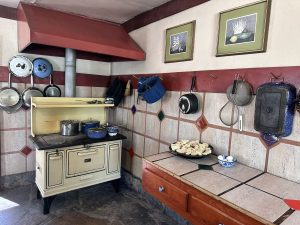
Tall Tine guides have been hunting this region of Mexico for over two decades. Jaycox goes out of his way to have everything lined up, making it easy for hunters to cross international borders with ammunition, firearms, or permits. There are options in camp to reduce time and paperwork at the Mexican border and return home. He has mastered all the paperwork required to hunt and return home with our trophy.
Ted met us at the Gadsden in the morning to make the trip to Rancho Mababi, about 50 miles from the Arizona border. The picturesque ranch of about 23,000 acres is nestled against the towering Sierra Madre Mountains in Sonora, Mexico. The drive is about two hours long and provides a first-hand experience and view into rural Mexican life.
Rancho Mababi Mexico
Rancher, philanthropist, and former Silicon Valley executive Alice Valenzuela met us at her home, where we would stay. Alice and her late husband moved to Rancho Mababi when their kids were young to reestablish the important things in life.
Shortly after arriving at the ranch, the staff took our luggage to the various cottage-like structures. Adobo architecture was used to build the structures, using a prehistoric sun-dried brick construction made of indigenous loam, sand, or alluvial clay mixed with straw, tile chips, or other binder material. The buildings stay warm in the winter and cool in the summer and offer all of a home’s amenities. I hunted from the ranch for Coues deer and loved the quaint, comfortable, rustic setting.
Alice and the crew still use a woodstove to cook and bake everything served to guests. The meals offer an authentic taste of the region with lots of turkey options for successful hunters.
Day one

It didn’t take long to enjoy lunch, unpack, and head to the range to pattern shotguns. Ted had a Mossberg 940 Pro Turkey shotgun with a red dot sight. I had ordered Apex Ammunition Turkey Tungsten Super Shot and had it shipped to Ted earlier in the year. When hunting a trophy bird, superior shotguns and advantage-driven shotshells are recommended.
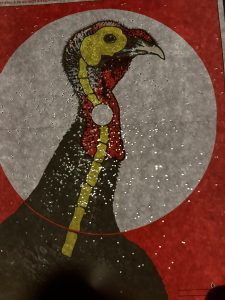
One minor adjustment to the sight was required to shoot the densest and centered patterns I have ever seen. The 3-inch 2 ¼-ounce blend of tungsten pellets offers increased range, superior penetration, reduced recoil, and extremely dense patterns with high pellet counts. After long travel days, high expectations, and a budget saved to plan the trip, nothing was left to chance.
The afternoon sun was making its way west when we headed for our hunting blinds. Ted, Mike, and I traveled down a ranch road to a large pop-up blind at the base of a ridge along a shallow creek bed. It was a great-looking turkey location, and we set up decoys and ran a string from the breeding gobbler decoy to our blind. A couple of twitches on the string put the decoy in motion to help finish rival gobblers that might travel into sight.
Hunting Gould’s turkeys with a Mossberg 940 Pro Turkey
Ted hid the truck in the next draw and snuck back to the blind to settle in for the evening. The oak-covered ridges were great areas for birds to hang out in during the day’s heat and were a known travel route for birds heading to roost trees farther down the creek. Ted had used the location in previous years and explained that birds could approach from any direction. Ted looked at us and asked who was going to shoot first. Mike had the perfect answer when he said I would shoot if a bird came from my side, and he would shoot if a gobbler approached from his end. It was the perfect way to let the birds decide who the shooter would be. The excitement was building.

Some soft hen calls were scratched from a slate. Ted used several diaphragms and other turkey calls, but they were used occasionally, not wanting to overdo it. We had been in the blind for about two hours when a loud gobble in my right ear made me flinch. There was no sign of the bird or indication that it was around until it sounded off. The turkey likely heard the hen’s calls and slowly headed to the creek through the trees. When it caught sight of the decoys, it gobbled.
I carefully peered out a crack in the blind and saw a bright head and tail fan about 25 yards away. The bird was on my side of the blind, meaning I needed to mentally prepare to shoot if the opportunity arose. Ted called gently, and the gobbler rattled like a barnyard bird being aggressive. I knew that a Gould’s turkey sounded different from other species of wild turkeys, and hearing it was almost comical. The bird tried to stay in a strut as it ran down the ridge. Downed logs blocked my view, but when the bird appeared beyond them, it was only 25 yards away and headed for the decoys. The Mossberg shotgun had already found its way to my shoulder, and the short barrel made it easy to maneuver in the blind and find the bird in the optic. The bird stopped, lifted its head slightly, and pulled the trigger.
The old warrior hit the ground and never flinched or twitched another feature. The tungsten load and Mossberg’s extra full choke shot the wiggle right out of him. I was almost in disbelief that the hunt was over. Everything happened so fast. It was as though it was scripted. Ted snuck out to retrieve the bird and place it behind the blind. We hadn’t disturbed the area, and a few soft hen calls resumed the hunt with Mike up to bat.
We didn’t wait an hour before movement to the right caught our attention. A nice long beard was in strut and looking toward our decoys. We didn’t see them at first, but an entire flock of turkeys was following, with at least four more gobblers in tow. Gobbles were thrown back and forth, and the aggressive tom started to trot toward the breeding gobbler decoy. It looked like a fight was imminent, but Mike saw his opportunity and shot when the bird was only a few feet from his plastic rival.
We quietly high-fived in the blind and sat back to watch the show with turkeys working the flat in front of our blind. A jake circled the decoys while several gobblers banded together to move in for a closer look. The hens were more interested in feeding, and after 15 minutes, the birds finally moved off and around the corner.
We gathered our prized birds and fussed over the unique feathers and colors. The Gould’s turkey is beautiful and much bigger than anticipated. My gobbler weighed in at 22.04 pounds. The tall, long-legged birds are well adapted to the desert environment and drastic temperatures. We took photos and tried to slow the setting sun to bask in the moment.
The birds were carefully skinned, tagged, and frozen at camp for transport home. The meat would be meals for several days. And, just when we thought it was over, Ted asked if we would be interested in getting up early the next day to check out activity at one of the other blinds. The excitement would continue, but this time with the long lens on my camera.
Gould’s turkey
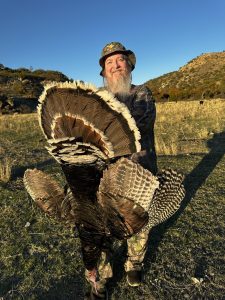
The Gould’s Turkey (Meleagris gallopavo mexicana) is the largest subspecies of wild turkeys living at high elevations in desert-like habitats. The Goulds have the smallest population and distribution of North American turkeys. It was first described by J. Gould in 1856 in northern Mexico, where it got its name. At the time, the species extended to southern Arizona and New Mexico. Fifty years later, the Gould’s Turkey had been hunted to near extinction but remained in remote and wilderness areas of Mexico.
In the 1990s, the Arizona Game and Fish Department and US Forest Service worked with the National Wild Turkey Federation to reintroduce Gould’s to that state. There are now huntable populations in Arizona and New Mexico, and limited licenses are available through a draw. Outfitters hunt strong Mexican populations.
The distinguishing features are long legs, big feet, and white-tipped oversized tail feathers. The back feathers have copper, green, and gold set against contrasting black.
World Slam and Royal Slam for turkeys
Harvesting a Gould’s turkey completed my Royal Slam and World Slam, as identified by the National Wild Turkey Federation. A turkey hunter must harvest and register the Ocellated turkey and all five subspecies of the American wild turkey, including the Eastern, Rio Grande, Merriam’s, Osceola, and Gould’s turkey. To complete a Royal Slam, a hunter must harvest and register an Eastern, Rio Grande, Merriam’s, Osceola, and a Gould’s turkey.
For more information on turkey slams and how to register, visit www.nwtf.org.
Mossberg 940 Pro Turkey – review from this hunt
Mossberg 940 Pro (purchase here from Scheels)
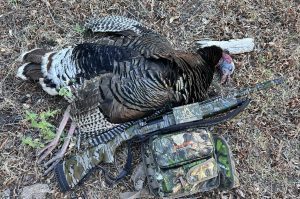
The 940 Pro Turkey shotgun is adjustable for fit and feel, with modifications to drop and cast, and the length-of-pull from 13 to 14.25 inches. The shotgun fits perfectly, allowing for easy alignment and accurate patterns. The barrel-making process facilitates shooters to maintain point-of-aim and impact.
The 940 series of shotguns was developed when Mossberg teamed up with legendary competitive shooters Jerry and Lena Miculek. The first model was launched in 2020 with a 12-gauge autoloading shotgun for competitive shooters, known as the 940 JM Pro. Mossberg saw the newly designed shotgun as a winner and implemented the technologies of a competitive-style platform to one that could benefit hunters. The 940 Pro Waterfowl and the 940 Pro Snow Goose were successfully launched, and the 940 Pro Turkey was a natural follow-up.
The 940 Pro Turkey has a taped receiver and is optic-ready. The shotgun is equipped with an HIVIZ CompSight Fiber Optic Sight for smoothbore enthusiasts wanting to stick to their roots. The complete 940 Pro line works with a clean-running gas-vent system. Hunters will appreciate well-thought-out features like the quick-empty magazine release and self-draining stock. The Turkey model has an 18.5- or 24-inch barrel and an X-Factor XX-Full Tky Tube.
The 940 Pro Turkey shotgun is adjustable and extremely fast cycling. The combination of new engineering and a ported barrel offers noticeable managed recoil. The shotgun is decorated in Mossy Oak Greenleaf and has special coatings for low maintenance and enhanced durability. www.mossberg.com
Apex Ammunition (purchase here from Scheels)
Apex Ammunition offers some unique packaging for its handcrafted, premium shotshells. The 3-inch 2 ¼-ounce blend of tungsten pellets offers increased range, superior penetration, reduced recoil, and extremely dense patterns with high pellet counts. There are options for shot size, with impressive pellet counts with 9 shots at 724 pellets, 8 at 510, and 7.5 at 440.

I opted for the Mossy Oak Greenleaf Turkey TSS, a blended load. It is offered in a unique and decorative box with five boxes of five shotshells and includes cigars to celebrate hunting success. The Mossy Oak Greenleaf Turkey TSS is available in:
3-inch, 12-gauge, 2 ¼ ounce,
3-inch, 20-gauge, 1 5/8 ounce
28-gauge, 1 ½ ounce
These Premium “Duplex” shells are made with a combination of No.9 and No.10 TSS, with a mindboggling payload of 1,096 pellets in 12-gauge shells. The 20-gauge has 774 pellets, and the 28-gauge has 665 for head crushing patterns. The tungsten has a density of 18.1 grams per cubic centimeter. Each shotshell is hand-loaded with premium components to provide exceptional patterns and maximum barrel protection.
ALPS Ambush Sling Pack (purchase here from Scheels)
Packing light for airplanes, rental cars, and international travel takes careful consideration. The ALPS OutdoorZ Ambush Sling Pack was ideal for daily taking the essentials into the field. The lightweight pack with a single ambidextrous strap can be slung over your shoulder for easy carry. When mounting the shotgun, the single strap frees your shooting shoulder from extra bulk. A MOLLE system on both sides of the pack provides secure attachment points—plenty of room in the main compartment for storage, and an additional ThermaCELL pocket helps cover the bases. The Ambush Sling Pack weighs one pound empty but holds snacks and essentials for a day in the field.
Tall Tine Outfitters
Ted Jaycox of Tall Tine Outfitters handles everything to take the worry away from his hunters. Firearms, ammunition, border crossing, and importation of wildlife are overseen to avoid challenges. Transportation is provided from Douglas to Ranch Mababi. Ted also offers hunts for Osceola, Ocellated, and Rio turkeys. For more information, visit their website.
All imported turkeys from Mexico must go to a USDA-approved taxidermist.
Per our affiliate disclosure, we may earn revenue from the products available on this page. To learn more about how we test gear, click here.








